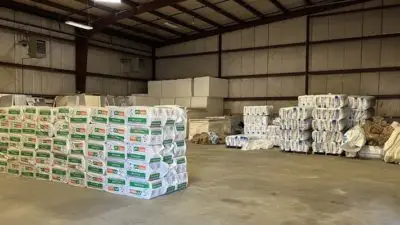Blown insulation in an attic
Tucked away in hard-to-see places it can be easy to forget about insulation in your home. However, insulation — or lack thereof — plays a significant role in the comfort level of your home and the amount of money you have to pay in utility costs each month.
There are a couple of key areas that are important to insulate in a home, specifically the walls and attic. It’s important to insulate walls because they take up so much surface area and attics because warm air rises and escapes out of the top of homes. If you are considering investing in this home improvement project, then the next step is to begin preparing.
What is Blown Insulation?
Blown-in insulation is a shredded-up newspaper product that is blown into a home through a hose. It’s a popular way to retrofit wall insulation as it’s an alternative to ripping down drywall to install fiberglass batting. Blown-in insulation is installed into walls by drilling a hockey puck-sized hole into the outside or inside of the home, running a hose into the cavity of the wall, and blowing in the cellulose at a high speed. Once the cavity is filled, the hose is snaked out and the hole plugged. It’s a minimally invasive way to rollback energy bills and cutback carbon footprints.
Many companies like HomeWorks also use the product in attic spaces as a way to add insulation to what’s already there. The current building code requires 12 inches of insulation in attic spaces. Many homes in the area have some insulation already, but most don’t meet the current building code. Blown-in insulation adds a thick blanket to the attic floor, filling in gaps that fiberglass batts inevitably leave during the installation process. A thick covering of attic insulation can go a long way in improving the comfort of your home.
Cellulose Insulation
How Can You Prepare Your Attic for Blown Insulation?
- Begin the preparation process by scheduling a home energy assessment. A home energy assessment allows a professional to evaluate the current efficiency of your home. They can identify key areas that can improve the efficiency of your home and offer specific solutions that can make an impact quickly. During this appointment, the home energy specialist can tell you whether or not blown insulation is the best way for you to reduce energy and lower your utility bills. In addition, you also will receive valuable information about other ways you can save energy in your home.
- Next, clean out your attic. Before blown insulation can be installed, your attic needs to be cleaned and organized. Now is the right time to purge those old holiday decorations that you haven’t displayed in years and also get those family photos archived properly. Make sure anything that doesn’t need to be in the attic is removed, and all valuables are properly stored in a secure area. You should eliminate as much dust and debris as possible before scheduling your appointment for blown insulation. Homeworks Energy offers storage removal options and removal as well, although that all comes at a cost that MassSave doesn’t incentivize.
- After your attic is organized and ready for installation, verify there are no water leaks in the area. You should do a thorough evaluation of the attic to look for signs of water damage. This may include damp wood in the attic or dried water lines in a particular area. If you do discover signs of water damage, you will want to make sure you address those issues before you have insulation installed.
- Protect any light fixtures in the attic. Blown-in insulation should not be applied directly around a light fixture, as this could increase the risk of fire in the home. To minimize this risk, you should create a box around your light fixtures. There should be a three-inch gap between the light fixture and the area where the insulation will be installed in the attic. A variety of materials can be used to create these boxes, such as plywood or metal flashings. HomeWorks Energy can perform this service.
- Verify the exhaust fans are blowing out. As you are cleaning and preparing your attic for blown-in insulation, you will want to check that all fans are exhausting properly, including bath fans and dryer hoses. If exhaust fans are dumping into the attic, excess moisture can lead to mold development.
Getting your attic ready for blown insulation is a relatively simple process that won’t take too much time. Once your attic is prepared for your upcoming insulation project, it’s time to schedule your appointment with a qualified insulation contractor. HomeWorks Energy can properly install cellulose insulation in your attic in order to ensure that you maximize your results from this investment.








